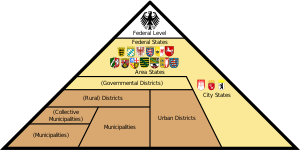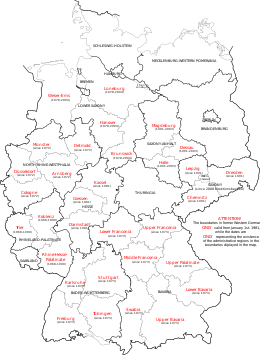

| This article is part of a series on the |
| Politics of Germany |
|---|
 |
| Constitution (Basic Law) |
| Head of State |
|
Executive
|
|
Legislature
|
Judiciary
|
|
Subdivisions
|
Elections
|
State and local politics
|
Foreign relations
|
|
Political ideologies
|
A Regierungsbezirk (German pronunciation: [ʁeˈɡiːʁʊŋsbəˌtsɪʁk] ) means "governmental district" and is a type of administrative division in Germany. Currently, four of sixteen Bundesländer (states of Germany) are split into Regierungsbezirke. Beneath these are rural and urban districts
Regierungsbezirke (pronounced [ʁeˈɡiːʁʊŋsbəˌt͡sɪʁkə] ) serve as regional mid-level local government units in four of Germany's sixteen federal states: Baden-Württemberg, Bavaria, Hesse and North Rhine-Westphalia. Each of the nineteen Regierungsbezirke features a non-legislative governing body called a Regierungspräsidium (governing presidium) or Bezirksregierung (district government) headed by a Regierungspräsident (governing president), concerned mostly with administrative decisions on a local level for districts within its jurisdiction. Saxony has Direktionsbezirke (directorate districts) with more responsibilities shifted from the state parliament.
Translations
Regierungsbezirk is a German term variously translated into English as "governmental district", "administrative district" or "province", with the first two being the closest literal translations.
History
The first Regierungsbezirke were established in the Kingdom of Bavaria and the Kingdom of Prussia in 1808. During the course of the Prussian reforms between 1808 and 1816, Prussia subdivided its provinces into 25 Regierungsbezirke, eventually featuring 37 such districts within 12 provinces. By 1871, at the time of German unification, the concept of Regierungsbezirke had been adopted by most States of the German Empire. Similar entities were initially established in other states under different names, including Kreishauptmannschaft (district captainship) in Saxony, Kreis (district) in Bavaria and Württemberg (not to be confused with the present-day Kreis or Landkreis districts), and province in Hesse. The names of these equivalent administrative divisions were standardized to Regierungsbezirk in Nazi Germany, but after World War II these naming reforms were reverted.
The Regierungsbezirke in the state of North Rhine-Westphalia in modern Germany are in direct continuation of those created in the Prussian Rhine and Westphalia provinces in 1816. Regierungsbezirke never existed in Bremen, Hamburg, Schleswig-Holstein, and Saarland.
In 1946, Lower Saxony was founded by the merger of the three former Free States of Brunswick, Oldenburg, Schaumburg-Lippe, and the former Prussian province of Hanover. Brunswick and Oldenburg became Verwaltungsbezirke [fɛɐ̯ˈvaltʊŋsbəˌt͡sɪʁkə] (roughly administrative regions of extended competence) alongside six less autonomous Prussian-style Regierungsbezirke comprising the Province of Hanover and Schaumburg-Lippe. These differences in autonomy and size were levelled on 1 January 1978, when four Regierungsbezirke replaced the two Verwaltungsbezirke and the six Regierungsbezirke: Brunswick and Oldenburg, Aurich, Hanover (remaining mostly the same), Hildesheim, Lüneburg, Osnabrück and Stade.
Following the reunification of Germany in 1990, the territory of the former East Germany was organized into six re-established new federal states, including a reunified Berlin. Saxony and Saxony-Anhalt established three Regierungsbezirke each, while the other new states didn't implement them.
2000s disbandment and reorganization
During the 2000s, four German states discontinued the use of Regierungsbezirke. On 1 January 2000, Rhineland-Palatinate disbanded its three Regierungsbezirke of Koblenz, Rheinhessen-Pfalz and Trier. The employees and assets of the three Bezirksregierungen (German pronunciation: [bəˈt͡sɪʁksʁeˌɡiːʁʊŋən] ) were converted into three public authorities responsible for the whole state, each covering a part of the former responsibilities of the Bezirksregierung (German: [bəˈt͡sɪʁksʁeˌɡiːʁʊŋ] ).
On 1 January 2004, Saxony-Anhalt disbanded its three Regierungsbezirke of Dessau, Halle and Magdeburg. The responsibilities are now covered by a Landesverwaltungsamt (county administration office) with three offices at the former seats of the Bezirksregierungen. On 1 January 2005, Lower Saxony followed suit, disbanding its remaining four Regierungsbezirke of Brunswick, Hanover, Lüneburg, and Weser-Ems.
On 1 August 2008, Saxony restructured its counties (Landkreise, German: [ˈlantˌkʁaɪ̯zə] ), changed the name of its Regierungsbezirke to Direktionsbezirke (directorate districts), and moved some responsibilities to the districts. The Direktionsbezirke were still named Chemnitz, Dresden, and Leipzig, but a border change was necessary because the new district of Mittelsachsen crossed the borders of the old Regierungsbezirke. On 1 March 2012, the Direktionsbezirke were merged into one Landesdirektion (county directorate).
Regierungsbezirke by state
Currently, only four German states out of 16 in total are divided into Regierungsbezirke; all others are directly divided into districts without mid-level agencies. Those four states are divided into a total of 19 Regierungsbezirke, ranging in population from 5,255,000 (Düsseldorf) to 1,065,000 (Gießen):
- Baden-Württemberg: Freiburg, Karlsruhe, Stuttgart, Tübingen
- Bavaria: Upper Bavaria, Lower Bavaria, Upper Palatinate, Upper Franconia, Middle Franconia, Lower Franconia, Swabia
- Hesse: Darmstadt, Gießen, Kassel
- North Rhine-Westphalia: Arnsberg, Cologne, Detmold, Düsseldorf, Münster
List of historic former Regierungsbezirke
- Prussia
- Berlin, comprising the city and several suburbs, incorporated into Regierungsbezirk Potsdam of Brandenburg in 1822
- Kleve, Province of Jülich-Cleves-Berg, incorporated into Düsseldorf region in 1822
- Reichenbach, Province of Silesia, incorporated into Breslau and Liegnitz regions in 1820
- Stralsund, Province of Pomerania, incorporated into Stettin Region in 1932
- Dissolved in 1919/20 after cession of territory according to the Treaty of Versailles:
- Bromberg, Province of Posen
- Danzig, Province of West Prussia (see Free City of Danzig)
- Lorraine, Imperial Land of Alsace-Lorraine
- Lower Alsace, Imperial Land of Alsace-Lorraine
- Marienwerder, Province of West Prussia, re-established as West Prussia region of the East Prussia province in 1922
- Posen, Province of Posen
- Upper Alsace, Imperial Land of Alsace-Lorraine
- Established after the 1939 Invasion of Poland, dissolved in 1945:
- Hohensalza, Reichsgau Wartheland
- Kattowitz, Province of Silesia (Upper Silesia from 1941)
- Litzmannstadt (Kalisch until 1941), Reichsgau Wartheland
- Posen, Reichsgau Wartheland
- Zichenau, Province of East Prussia
- Former eastern territories, dissolved in 1945:
- Allenstein, Province of East Prussia
- Breslau, Province of Silesia (Lower Silesia 1919–1938, 1941–1945)
- Frankfurt, Province of Brandenburg
- Gumbinnen, Province of East Prussia
- Köslin, Province of Pomerania
- Königsberg, Province of East Prussia
- Liegnitz, Province of Silesia (Lower Silesia 1919–1938, 1941–1945)
- Oppeln, Province of Silesia (Upper Silesia 1919–1938, 1941–1945)
- Posen-West Prussia (Schneidemühl), Province of Pomerania, established in 1938
- Stettin, Province of Pomerania
- Allied-occupied Germany:
- Erfurt, dissolved in 1944/1945
- Frankfurt, dissolved in 1945, Province of Brandenburg
- Liegnitz, Province of Silesia, dissolved in 1945
- Magdeburg, dissolved in 1945, reestablished in 1990 and redissolved in 2004
- Merseburg, dissolved in 1944/1945
- Minden, Province of Westphalia, incorporated into Detmold in 1947
- Potsdam, dissolved in 1945, Province of Brandenburg
- Schleswig, dissolved in 1946, Province of Schleswig-Holstein
- Sigmaringen, Province of Hohenzollern, incorporated into Württemberg-Hohenzollern in 1946.
- Stettin, dissolved in 1945, Province of Pomerania
References
- Regional Governments in France, Germany, Poland and The Netherlands (HTML version of PowerPoint presentation) – Cachet, A (coordinator), Erasmus University, Rotterdam
- "regierung.oberbayern.bayern.de". Archived from the original on 3 January 2013. Retrieved 3 February 2013.
- regierung.oberfranken.bayern.de
- "regierung.unterfranken.bayern.de". Archived from the original on 18 June 2015. Retrieved 3 February 2013.
- Jablonsky, David. The Nazi Party in Dissolution: Hitler and the Verbotzeit 1923–25, London: Routledge, 1989, p. 27.
- Shapiro, Henry D. and Jonathan D. Sarna, Ethnic Diversity and Civic Identity, Illinois: UIP, 1992, p. 135.
External links
![]() Media related to Regierungsbezirk at Wikimedia Commons
Media related to Regierungsbezirk at Wikimedia Commons